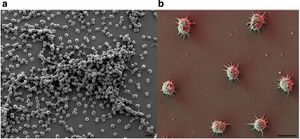Altiarchaeales
Section

By [Benjamin A. Canniff]
At right is a sample image insertion. It works for any image uploaded anywhere to MicrobeWiki.
The insertion code consists of:
Double brackets: [[
Filename: PHIL_1181_lores.jpg
Thumbnail status: |thumb|
Pixel size: |300px|
Placement on page: |right|
Legend/credit: Electron micrograph of the Ebola Zaire virus. This was the first photo ever taken of the virus, on 10/13/1976. By Dr. F.A. Murphy, now at U.C. Davis, then at the CDC.
Closed double brackets: ]]
Other examples:
Bold
Italic
Subscript: H2O
Superscript: Fe3+
Introduce the topic of your paper. What is your research question? What experiments have addressed your question? Applications for medicine and/or environment?
Sample citations: [1]
[2]
A citation code consists of a hyperlinked reference within "ref" begin and end codes.
Higher Order Taxa
Kingdom:Proteoarchaeota
- Domain: Archaea
- Phylum: Euryarchaeota
- Class: Unknown
- Order: Altiarchaeales
- Family: Altiarchaeaceae
- Order: Altiarchaeales
- Class: Unknown
- Phylum: Euryarchaeota
Section 2
- Genus: Altiarchaeum
- Species: Archaea
Description and Significance
Altiarchaeles are an order of uncultured Archaea that is a recently proposed order. The Altiarchaeles’ lineage is made up of genetically diverse and globally wide spread microorganisms that can be found in anoxic subsurface environments, and are one of the few archaea that have a double membrane. The entire cell wall consists of an outer membrane separated by a periplasmic space from the cytoplasmic membrane. In depth genome analysis suggests that Altiarchaeles are autotrophic, utilizing a modified version of the archaeal reductive acetyl-CoA pathway, otherwise known as the Wood-Ljungdahl pathway for metabolism [4].
Section 4
Conclusion
References
Authored for BIOL 238 Microbiology, taught by Joan Slonczewski, 2017, Kenyon College.
